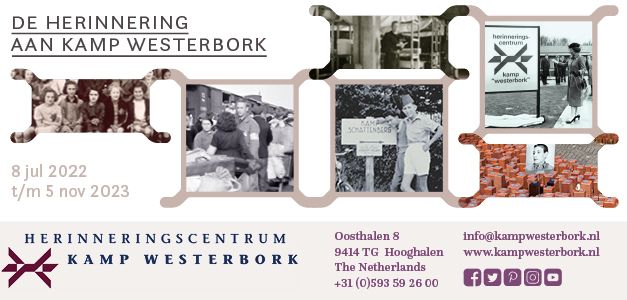
Remembrance Center Kamp Westerbork 40th anniversary.
August 5, 2022 - 1 min read
From July 8, 2022, the exhibition The Memory of Camp Westerbork can be seen in the Camp Westerbork Memorial Center. The exhibition explores the many meanings given to the historic site over the past 77 years and sheds light on them from different perspectives with the help of guest curators. Until September 2022, the Jewish survivors and relatives, Rozette Kats, Betty Schols-Meents, Alex Freddy Kan and Naomi Eliasar will give their own view on the past and present of camp Westerbork.
RTV Drenthe, broadcasting the exposition.
Alex is only thirteen years old when he is taken away by train to Sobibor. Where he ends up in the gas chamber. His father survives the war and has a new son. His name? Also Alex. The 'new' Alex, along with that name, also carries a heavy burden. His father sees him as the filling of the inky black hole that the war has struck in the family.
"He is literally instructed by his father to somewhat restore what he lost in the war," says researcher of Kamp Westerbork Memorial Center Bas Kortholt. The war may have been over for nearly 80 years, but Alex has never really known freedom.
Layering
According to Kortholt, Alex's story is just one of hundreds of thousands of stories that the memorial center could tell during the new exhibition that opened today. Part of the exhibition - which also includes Alex's story - is re-filled every two months by a guest curator. The other part is permanent.
"For many visitors who come here, the war seems very far away. But for some it is still something that happens every day," explains the researcher. "That is something we also want to convey. That Camp Westerbork is a completely different place for these people, the survivors and relatives, than visitors with children who come here during the holidays, for example."
According to memorial center director Bertien Minco, the new exhibition shows the layered history of the camp site. And not just that of transit camp for Jews, Sinti and Roma. "After the war it was also a repatriation camp for Indisch Dutch. And of course Woonoord Schattenberg, for the Moluccan Dutch."
A Dutch local TV Channel covered the exhibition.
If you want to visit this article and watch the documentary <a href="https://www.rtvdrenthe.nl/nieuws/14797823/nieuwe-expositie-kamp-westerbork-laat-zien-dat-na-bijna-tachtig-jaar-de-oorlog-nog-altijd-dichterbij-is-dan-je-denkt" target="_blank">klick here</a>